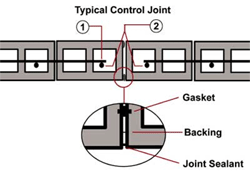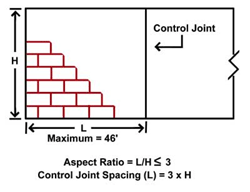Controlling the Cracking
Used wisely, control joints can reduce or eliminate cracking in concrete masonry unit walls.
Cracks in walls and building materials are due to several factors. The overall cause of cracks is having a constrained structure that is unable to move. Wall movement is inevitable and can be caused by structure settlement and drift, wind, moisture, heat and cold, and other conditions. Although these other factors are important, temperature and moisture content generally are the main conditions for movement in masonry materials, usually in the form of shrinkage.
Brick, as we all know, has a life of its own when introduced to moisture, heat and cold, leading to expansion and shrinkage.
"Concrete masonry, just like all concrete products, it's the largest volume that it will ever be at the time that it is constructed," says Dennis Gruber, Director of Technical Publications for the National Concrete Masonry Association. "It has moisture in it and as it dries out, it cures, and it shrinks. When it shrinks, it tries to pull the ends in and make the panel smaller. That's alright if it's not restrained, but it's restrained, as the wall is tied in to your foundation, roof and floor members, keeping it from pulling the ends in and from shrinking. This results in cracks, because masonry is much weaker in tension than it is in compression."
According to Carolinas Concrete Masonry Association, "A change of 50 degrees Fahrenheit will affect a 100-foot concrete wall with forces 410 PSI and movement of as much as 1/4 inch. Since the tensile strength of the wall is generally less than that, cracking generally occurs."
So how do you create a solid wall that allows for movement? Joints.
Concrete and Control Joints
Control joints, used effectively, will divide a large, solid wall into panels that facilitate longitudinal movement, thereby reducing the chances for cracks or limiting how much cracking actually occurs on the wall face.
"Control joints are for aesthetic and water penetration reasons," says Graber. "If it's an exterior wall and it's covered up with furring or something like that, they're just in there for aesthetic reasons. The shrinkage cracks don't inhibit the strength of the wall.
"The idea of control joints is to give a place so those joints can open up to reduce the restraint and, in essence, it's putting in pre-formed cracks. It's just a weakened plane joint so that when it dries out and it cracks, it cracks in a nice straight line. The way you do that is you rake out the mortar joints, so that they're weaker there, then you put a backer rod and sealant in so that you don't get water penetration."
The elastomeric sealant should be one that remains flexible, like a silicone sealant, and doesn't become hard or rigid. It should meet ASTM C920 standards and be installed using ASTM C962. In exterior walls it is especially important to keep the seal weather-tight, so the sealant should have good contact with the edges. By keeping the sealant thicker on the edges and thinner in the middle, around the backer rod, the sealant will remain more flexible and allow for movement without tearing.
In addition to the backer rod and sealant, a shear key with a gasket can be used in the joint for added load transfer. Joint reinforcement or bond beams can be used in conjunction to increase the tensile strength of the wall, whether laid in stacked bond or running bond patterns. Dowelled joints, although rarely used, can also be a way to transfer even higher loads at the joint.
 Figure 1: 1. Terminate all non-structural reinforcing 2" from control joints. 2. Additional vertical bars on each side of all control joints. |
 Figure 2: Control Joint Spacing (Reinforced Wall Example) |
Location, location, location
Control joints should be placed where high amounts of lateral stress loads occur ? a structural engineer should be consulted before construction. These locations include:
- In long, straight walls
- At abrupt changes in wall thickness or height
- At chases for pipes, fixtures, etc.
- On one or both sides of wall openings
- At bond beam breaks
- At abutment of walls and columns or pilasters
- At wall intersections in main walls or partitions
- At construction joints in foundations, roofs or floors
- At return angles in "L," "T" or "U"-shaped structures
- When brick or stone veneer is applied to block
A good rule of thumb is to place control joints every 20 linear feet. The American Concrete Institute recommends the following spacing:
| Maximum Spacing of Joint Reinforcement | Maximum Spacing of Control Joints | |
| . | Panel length/height | Panel length |
| None | 2.0 | 12m |
| 600mm | 2.5 | 14m |
| 400mm | 3.0 | 15m |
| 200mm | 4.0 | 18m |
In earthquake regions, the maximum spacing should be limited to 15 meters in reinforced masonry construction, while the space from the corner to the joint should be 7.5 meters (CCI Industries, Ltd.).
Control joints should be placed on one side or the other of an opening less than six feet wide; control joints should be placed at both jambs of openings over six feet wide. However, these joints may be omitted if adequate tensile reinforcement is placed above or below wall openings.
"If it's reinforced and you put reinforcement around your opening, then you don't need control joints around the opening," says Graber. "If you get a crack, it's going to occur at the weakest point in the wall, which means where it has the least amount of masonry to go through and, if you have a big opening in the wall, that's usually where it will go through. If you put reinforcement all the way around the opening to intercept that crack and hold it tightly together, then you can put the control joints beside them."
| Reinforcement Location | Maximum Distance Bewtween Joints |
| None | 20 feet |
| 24" on center | 22.5 feet |
| 16" on center | 25 feet |
| 8" on center | 30 feet |
When using joint reinforcement, the following should be implemented:
By following these rules of thumb, your concrete masonry should maintain it's visual appearance for the life of the building.
The Flipside: Expansion Joints
There are other joints that should be used with brick masonry. Clay bricks will expand far more than they shrink, so expansion, or movement, joints are necessary.
"Movement or expansion joints are typically designed for clay or calcium silicate veneers," says Craig Swirzon, technical representative for Arriscraft International. "Control joints are typically designed in CMU wall systems. It's just the nature of the two materials. Concrete tends to shrink over time and clay brick tends to grow over time. So you have materials moving in opposite directions."
"The major cause of movement, when you're dealing with clay brick, is the moisture," says Michael Gurevich, masonry consultant for New York City Brickwork Design Center. "So generally, when brick is manufactured, it is fired in the kiln at a temperature of about 2000 degrees. When it's coming out of the kiln, brick will absorb moisture out of the air and will expand. Sometimes it happens in the first couple of years, sometimes in the first couple of months. And brick is actually expanding, moisture-wise, and growing. But one of the most serious issues here is that about 95 percent of that the moisture expansion of the brick is irreversible.
"A forty-foot long or high brick veneer panel will grow for approximately a quarter of an inch, and will not go back. It's a moisture expansion, again ? it's for clay brick only. Now if you're dealing with concrete, it's a completely different issue."
Due to these differences, mason contractors need to utilize the correct joint for the proper material and application.
"A lot of designers do call movement joints or expansion joints on the veneer as control joints," says Swirzon, "but that's just one of those things where you say, 'Ok, control joints are this specific thing; a movement or expansion joint is this over here.' One's hard, one's soft. We're trying educate everybody so that they know the differences between the two."
For more information about expansion joints, Michael Gurevich is offering a seminar, "Expansion Joints in Brick Work," at the New York City Brickwork Design Center on January 28, 2003. To register in advance, call (212) 684-4229.
About the Author
Jennie Farnsworth is an Atlanta-based freelance writer and editor. She is a former editor of Masonry magazine.


















